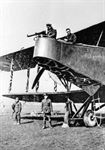Фотографии
-
A pair of Royal Aircraft Factory B.E.2cs flank a Deperdussin Monoplane, both types flown by Buss during his wartime flying career, at Felixstowe in 1915. The 100 h.p. Gnome-engined Deperdussin saw RNAS service in small numbers.
Самолёты на фотографии: Deperdussin B/C/D/TT - Франция - 1911RAF B.E.2c/B.E.2d - Великобритания - 1914
-
Самолёты на фотографии: RAF R.E.8 - Великобритания - 1916
-
In June 1915 No 2 Sqn RNAS was reformed as No 2 Wing, which was deployed to the Dardanelles two months later. This group photograph of No 2 Wing’s C Flight, with Buss seated third from right, was taken at Imbros in 1916, with an Avro 504B as a backdrop, although the unit used a wide variety of types while in Turkey.
Самолёты на фотографии: Avro Avro 504 - Великобритания - 1913
-
Despite Buss’s dislike of it, the Avro 504 quickly proved to be one of the most ubiquitous aircraft in RNAS service. The 504C, as seen here, was a single-seat version created specifically for anti-Zeppelin patrols and used extensively by the RNAS.
Самолёты на фотографии: Avro Avro 504 - Великобритания - 1913
-
Three O/100s of No 7 Sqn at Coudekerque, the nearest with its port wing still folded, are prepared for another bombing sortie. In July 1917 it was decided that the Handley Page squadrons would be restricted to ten aircraft apiece so No 7A Sqn was formed, becoming No 14 Sqn RNAS that December.
Самолёты на фотографии: Handley Page H.P.11 (O/100) - Великобритания - 1915
-
Регистрационный номер: 1459 The first O/100 in France, 1459, flew to Paris in October 1916 and joined No 7 Sqn at Coudekerque in April 1917, although it was used for trials with the 6in recoilless Davis Gun over the next few months. Note the mottled camouflage applied to the lower surfaces to improve concealment during moonlight bombing raids
Самолёты на фотографии: Handley Page H.P.11 (O/100) - Великобритания - 1915
-
Самолёты на фотографии: Handley Page H.P.11 (O/100) - Великобритания - 1915
-
Horace Buss at the controls of a No 7 Sqn RNAS Handley Page O/100 on approach to Coudekerque, a few miles inland from Dunkirk, as seen from the rear gunner’s position. Early daylight raids by No 7 Sqn’s O/100s on U-boat bases along the Belgian coast were quickly suspended and replaced by nocturnal bombing sorties.
Самолёты на фотографии: Handley Page H.P.11 (O/100) - Великобритания - 1915
-
Horace Austen Buss poses in the cockpit of the Blackburn Monoplane shortly after having gained his Royal Aero Club Certificate in February 1913. Buss would become one of the early Royal Naval Air Service pioneer pilots. Although he is referred to in many sources as Harold Buss, he was most definitely a Horace!
Самолёты на фотографии: Blackburn Type I - Великобритания - 1913
-
Horace Buss aloft in the sole Blackburn Single-Seat Monoplane over Knavesmire, part of York racecourse, in June 1914. The aircraft, powered by a 50 h.p. Gnome engine, was put into storage upon the outbreak of war later that year, and was rediscovered by Richard Shuttleworth in 1938. It still flies today with the Shuttleworth Collection.
Самолёты на фотографии: Blackburn Type I - Великобритания - 1913
-
Регистрационный номер: 1226 One of a number of biplanes evolved from an original monoplane design by Rumanian aeronautical pioneer Henri Coanda, the Bristol T.B.8 first flew in August 1913, before going on to serve with the RNAS on patrol and training duties during 1914-16. This example, 1226, is one of the first batch of 12 delivered to the RNAS in November 1914.
Самолёты на фотографии: Bristol BR.7 / TB.8 / GB.75 - Великобритания - 1913
Статьи
- -
- A.Tincopa - Wings over Peru
- B.Turpin - Out on a Lympne (1)
- C.Gibson - Swing-wing London?
- D.Green - Biggin or Bust!
- J.Forsgren - The Imperfect 10
- J.Franzi - An Eye on the Prize /An eye for detail/
- J.Stroud - To Belfast by Jupiter! /The John Stroud Archive/
- M.Parry - Major Horace Buss
- N.Stroud - Viva Las Vegas!
- P.Davidson - Off the Beaten Track...
- P.Fiddian - The Stefan Karwowski Factor
- P.Jarrett - Lost & Found
- P.Vabre - Paper Trails in the Sky
- R.Forsyth - Defending the Reich (1)
- T.Cooper - Baptism of War










